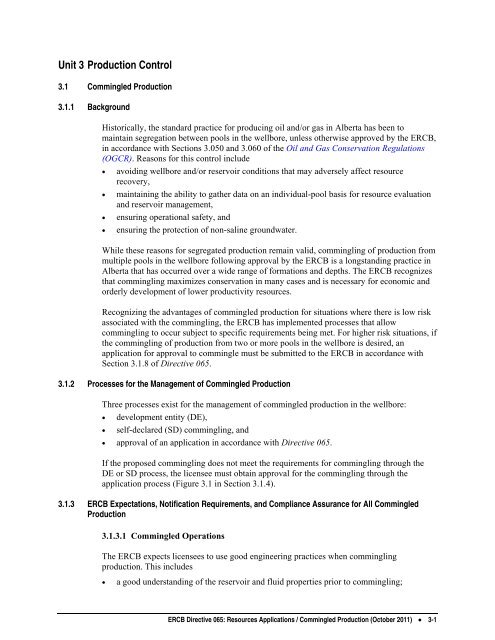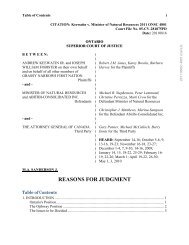Directive 065: Resources Applications for Oil and Gas Reservoirs ...
Directive 065: Resources Applications for Oil and Gas Reservoirs ...
Directive 065: Resources Applications for Oil and Gas Reservoirs ...
You also want an ePaper? Increase the reach of your titles
YUMPU automatically turns print PDFs into web optimized ePapers that Google loves.
Unit 3 Production Control<br />
3.1 Commingled Production<br />
3.1.1 Background<br />
Historically, the st<strong>and</strong>ard practice <strong>for</strong> producing oil <strong>and</strong>/or gas in Alberta has been to<br />
maintain segregation between pools in the wellbore, unless otherwise approved by the ERCB,<br />
in accordance with Sections 3.050 <strong>and</strong> 3.060 of the <strong>Oil</strong> <strong>and</strong> <strong>Gas</strong> Conservation Regulations<br />
(OGCR). Reasons <strong>for</strong> this control include<br />
• avoiding wellbore <strong>and</strong>/or reservoir conditions that may adversely affect resource<br />
recovery,<br />
• maintaining the ability to gather data on an individual-pool basis <strong>for</strong> resource evaluation<br />
<strong>and</strong> reservoir management,<br />
• ensuring operational safety, <strong>and</strong><br />
• ensuring the protection of non-saline groundwater.<br />
While these reasons <strong>for</strong> segregated production remain valid, commingling of production from<br />
multiple pools in the wellbore following approval by the ERCB is a longst<strong>and</strong>ing practice in<br />
Alberta that has occurred over a wide range of <strong>for</strong>mations <strong>and</strong> depths. The ERCB recognizes<br />
that commingling maximizes conservation in many cases <strong>and</strong> is necessary <strong>for</strong> economic <strong>and</strong><br />
orderly development of lower productivity resources.<br />
Recognizing the advantages of commingled production <strong>for</strong> situations where there is low risk<br />
associated with the commingling, the ERCB has implemented processes that allow<br />
commingling to occur subject to specific requirements being met. For higher risk situations, if<br />
the commingling of production from two or more pools in the wellbore is desired, an<br />
application <strong>for</strong> approval to commingle must be submitted to the ERCB in accordance with<br />
Section 3.1.8 of <strong>Directive</strong> <strong>065</strong>.<br />
3.1.2 Processes <strong>for</strong> the Management of Commingled Production<br />
Three processes exist <strong>for</strong> the management of commingled production in the wellbore:<br />
• development entity (DE),<br />
• self-declared (SD) commingling, <strong>and</strong><br />
• approval of an application in accordance with <strong>Directive</strong> <strong>065</strong>.<br />
If the proposed commingling does not meet the requirements <strong>for</strong> commingling through the<br />
DE or SD process, the licensee must obtain approval <strong>for</strong> the commingling through the<br />
application process (Figure 3.1 in Section 3.1.4).<br />
3.1.3 ERCB Expectations, Notification Requirements, <strong>and</strong> Compliance Assurance <strong>for</strong> All Commingled<br />
Production<br />
3.1.3.1 Commingled Operations<br />
The ERCB expects licensees to use good engineering practices when commingling<br />
production. This includes<br />
• a good underst<strong>and</strong>ing of the reservoir <strong>and</strong> fluid properties prior to commingling;<br />
ERCB <strong>Directive</strong> <strong>065</strong>: <strong>Resources</strong> <strong>Applications</strong> / Commingled Production (October 2011) • 3-1
















